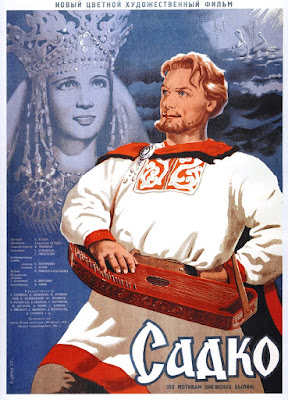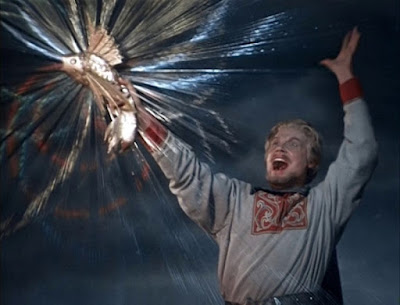(1953) Directed by Aleksandr Ptushko; Written by Konstantin
Isaev; Based on the opera by Nikolai Rimsky-Korsakov; Starring: Sergey
Stolyarov, Alla Larionova, Ninel Myshkova, B. Surovtsevand, Mikhail
Troyanovskiy and Nadir Malishevsky; Available on DVD
Rating: ****
“The wise man boasts of his father and mother. The fool boasts of his young wife, the merchant boasts of his fat purse, and the rich man of his gold…” – Sadko (Sergey Stolyarov)
Many Westerners were introduced to Sadko in the early ‘60s (a decade after its release in Europe), under the misleading title, The Magic Voyage of Sinbad.* Yet another generation of viewers became aware of the film when it received the Mystery Science Theater 3000 treatment in the early ‘90s. While elements of the lavish production still managed to shine through, it was easy (for those who only had the chance to watch a distillation of an already compromised film) to get the impression that this wasn’t a quality movie. In fact, the Soviet production had nothing to do with Sinbad or his adventures. Instead, Sadko originated from a Russian folktale (an Onega epic story), as well as the eponymous 1898 opera by Nikolai Rimsky-Korsakov.
* Fun Fact #1: When Sadko was adapted for American audiences, it was re-written, re-edited, and dubbed, under the supervision of a young Francis Ford Coppola (working for American International Pictures).
The good-natured troubadour Sadko arrives in the walled city
of Novgorod,* armed only with his psaltery (a traditional stringed instrument).
He barely sets foot off the boat before he’s created trouble for himself with a
group of merchants, calling them out for being obsessed with their wealth and
possessions. Although he wins his wager with the merchants, his attempt to redistribute
the wealth among Novgorod’s impoverished residents backfires. Realizing that
good intentions only bring him so far, our idealistic protagonist assembles a
crew, setting sail for parts unknown (leaving behind his one true love, Lyubava,
played by Alla Larionova), on a quest to find the fabled Bird of Happiness. Along
the way, he’ll encounter hostile Vikings, a capricious Indian prince, and the
jovial King of the Sea.
* Fun Fact #2: The full-scale walls, which were reportedly “dozens of meters high,” were constructed in Pestovo, outside of Moscow.
One of the distinguishing characteristics of Sadko (whose
name means “sonorous”), played by Sergey Stolyarov,* is that he fails more than
he succeeds, making him instantly more relatable than most epic heroes. While
his exploits appear larger than life, his fallibility keeps him grounded. He
possesses many admirable traits (charismatic, good-hearted), but he’s also
headstrong and impulsive. After capturing a valuable golden-finned fish, he squanders
his new fortune on a small segment of the poor before discovering he can’t help
everyone. Despite this setback, he never loses his resolve to bring happiness
to the people. Stolyarov’s performance walks the line between youthful arrogance
and uncertainty, ultimately winning us over through his character’s inherent vulnerability.
* Another Fun Fact #3: According to Stolyarov’s son, Kirill, the actor grew up as an orphan, and once worked as a train engineer.
The unsung hero of the film is unquestionably the sea
princess Vasya (Ninel Myshkova), who gets Sadko out of a jam on several occasions.
If not for her, his head (quite literally) would have been on the chopping
block. Despite her efforts to win Sadko’s heart, however, Vasya’s love remains unrequited.
As a final selfless gesture, she conspires to whisk him away from her watery
home, which rankles the feathers of her parents, the endlessly bickering King
of the Sea and his wife (Stepan Kayukov and Olga Viklandt).
Anyone acquainted with The Wizard of Oz won’t be
surprised by Sadko’s lesson about searching for happiness. Then again,
as with many fairytale stories, it’s the journey, not the conclusion that we’ve
come to experience and embrace. Among its many charms are the imaginative sets,
designed by Evgeniy Svidetelev, and colorful costumes created by Olga
Kruchinina of the Bolshoi Opera. Some visual highlights include the Indian city
(shot in Calcutta), complete with elephants and a bustling bazaar, along with a
suitably cavernous and ornate palace set. The undersea kingdom is a fanciful
depiction, worthy of a storybook, and the soft focus in many of the scenes only
adds to the dreamlike feel of the film. Director Aleksandr Ptushko and crew’s unabashedly
theatrical approach suits the material perfectly, immersing us in an unreal
world where illusions of reality need not apply. It’s a timeless, enchanting fairy
tale classic that deserves to be re-discovered and re-evaluated on its own
terms.







Intriguing review, Barry!
ReplyDeleteFrom your description, this is either a film that would totally draw me in or totally repel me. There would be no in between.
somehow I missed the mystery science theater 3000 version! I don't know how that's possible! LOL
Thanks, John. Personally, I think you'd dig it. It's so much giddy fun. Although the MST 3K version wouldn't be the ideal way to see it, you'd get an idea what you're in for.
DeleteHaven't seen this in a while, but it is quite a big-budget picture. I've seen a few of Ptushko's movies and really like his work. The undersea kingdom is a definite highlight.
ReplyDeleteIt's such a visual treat. This is only the second Ptushko movie I've seen (other than Ilya Muromets), but I hope to see more.
Delete